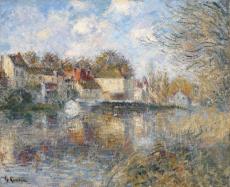


T he son of a family of modest means, Gustave Loiseau was essentially an autodidact; he was trained by decorators and the painter Fernand Quignon (1854-1941), who advised him to go and work in Pont-Aven in 1890. There, in this Breton artists’ colony, he met Maxime Maufra (1861-1918) and Henry Moret (1856-1913) and then, in 1894, the most famous among Pont-Aven’s artists, Paul Gauguin (1848-1903). The influence of the latter on Loiseau was limited since, being primarily a landscape artist, it was more the style of Claude Monet (1840-1926) that guided the young painter’s style. Loiseau painted in Paris and the region around the city, as well as in Normandy, but throughout his career he remained on a constant quest – along the banks of the Seine, in Brittany and the Dordogne – for new locations. In 1895, at an exhibition held at the Société Nationale des Beaux-Arts, Loiseau attracted the attention of the art dealer Paul Durand-Ruel (1831-1922), who had first promoted the Impressionists and who, in 1897, placed him under contract and proceeded to organise regular exhibitions of his work, the first of which took place in 1901. The commercial success of his work allowed Loiseau to dedicate himself exclusively to his art. The final years of his career were spent between Pontoise, where he is buried, and Moret-sur-Loing, a small town on the River Loing which Alfred Sisley (1839-1899) had made famous.
Undated by the painter and not listed in Durand- Ruel’s photographic archive, the scene depicted in Canal à Moret-sur-Loing can be compared to a painting by Loiseau with a similar subject, with the exception of the foreground, dated with certainty to c. 1934-1935.1 There, one can see the same system of fine, scratchy brushstrokes, and the opposition of hatched sections to supple curves, as in the case of the branches on the right, which are characteristic of the artist. This canvas, which is dedicated to the expression of the light, features coloured reflections shimmering in the water and attests to Loiseau’s loyalty to the great themes of Impressionism
He was essentially self-taught as a landscape and cityscape painter. In 1890 he went to the artists’ colony at Pont-Aven, where he met Paul Gauguin. As part of the second generation of Impressionist painters, however, he worked more in the tradition of Claude Monet. His work was admired by contemporaries for his balance of light and dark contrasts, his handling of light and his rendering of the seasons. From the 1920s he also painted many still lifes.